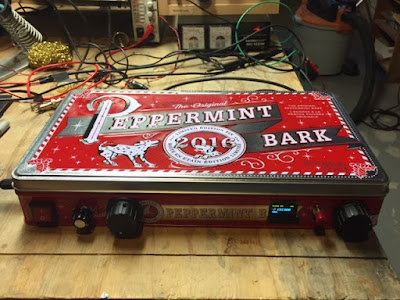Bill and Pete:
Can’t say enough good things about your podcast - thanks for all that you do. I’m a fairly new ham and have been trying to go the home-brew route as much as possible.
I bought a BITX40 module (pre Raduino vintage) and added my own VFO board using the usual parts. Actually, I’m using a Teensy 3.2 instead of an Arduino because it is a faster part and has a lot of DSP functions built into it that I’m using for digital mode stuff. But it’s the same basic idea.
My BITX40 is not as photogenic as some of the others, but I sent a picture below. This is the “biscuit tin” variety. It’s was funny actually: a co-worker of mine stopped by my office around Christmas to give me a gift and pulled out of his bag a very nice box of “peppermint bark” candies with a ribbon around it. The VERY FIRST thing that crossed my mind the instant I saw the gift was …. BITX40 ENCLOSURE! He must have been pleased to see the huge smile that came across my face. :-) I’ve been bitten by the bug for sure.
My first three HF QSOs (ever) where on the BITX and were all very interesting:
- First real QSO of my life was with KE4TJB “air-born mobile” off Delaware. He is a commercial pilot flying for JetBlue and apparently has time to work QRP stations during flights?? I wonder who was flying the plane?
- Then I was scanning around this morning and caught K4HW making last calls for check-ins on a net running on 7242 out of North Carolina. I decided to give it a shot, having never joined an HF net and I was recognized! As the first round got going I realized I had joined a Jehovah’s Witnesses net. They were very friendly and the net control stopped to help my get my frequency calibrated before they continued with the scripture passage for the week.
- Later this morning I reached K3KLC in Maryland who had the high-end SDR rig with the waterfall/panadaptor/etc. Remembering comments that you guys have made about these types of folks on 40m, I was very concerned. But this guy turned out to be very helpful and sent me some screen shots showing what my signal looks like.
Thanks again, and 73s,
Bruce MacKinnon
KC1FSZ
Wellesley, MA





























